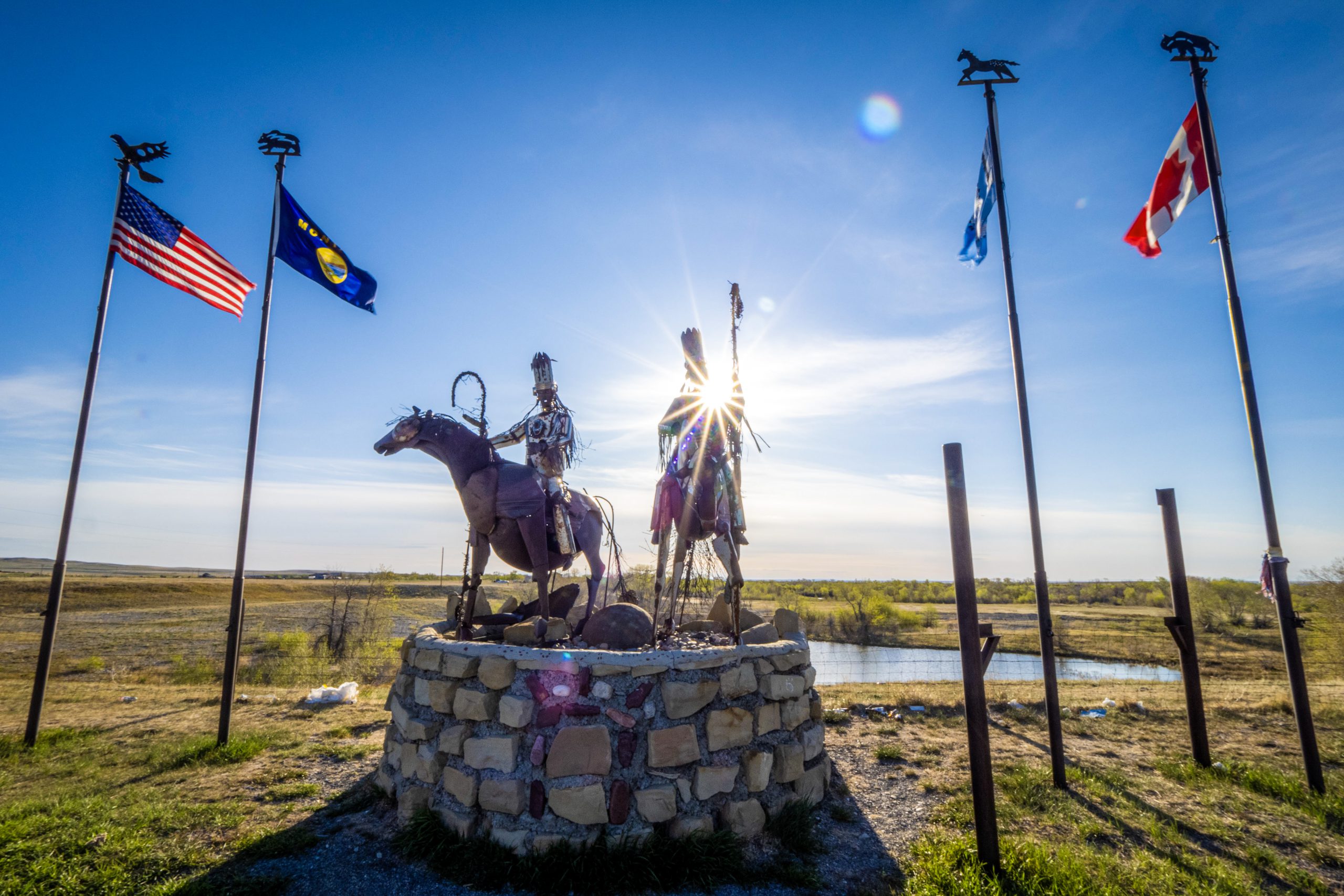Media share from Indianz.com on January 31st, 2024, featuring our own Marvin Weatherwax, Jr. – please read their article using the link below:
MEDIA SHARE ARTICLE
‘Fractionation just spirals unless you stop it’: Tribes call for more land consolidation funding (Indianz.Com media share)
Tribes call for more land consolidation funding
Wednesday, January 31, 2024
By Acee Agoyo
Indianz.Com
WASHINGTON, D.C. — The Biden administration was a no-show at a hearing called to examine the future of land consolidation efforts in Indian Country. But tribes stepped up with an important message.
Darryl LaCounte, the director of the Bureau of Indian Affairs, was scheduled to testify in the nation’s capital about the need to address the loss of land on reservations. But he was unable to make it due to illness, the Republican leader of the House Subcommittee on Indian and Insular Affairs said on Tuesday morning.
“I will state that I am disappointed in BIA’s absence, as their involvement in these discussions is critical to finding workable solutions,” said Rep. Harriet Hageman (R-Wyoming), a new member of the U.S. Congress.“So hopefully we will have the opportunity to engage them before too much more time passes,” said Hageman.
Despite the absence of a key government official, tribal and Indian leaders were still able to impress upon lawmakers about the importance of land consolidation. They called on Congress for more money and more resources to ensure that their homelands stay in their hands, as promised by treaties, existing laws and other government-to-government agreements.
“More funding is needed,” Chairwoman Victoria Kitcheyan of the Winnebago Tribe told the legislative panel. “And I would say we need to expand the scope of of how we reacquire the land.”
“In Winnebago — like many other reservations — there were many ways that we lost the land,” Kitcheyan said, citing the need for additional money to acquire expensive farming properties that are going up for sale on her tribe’s reservation in Nebraska.
“That’s our situation,” the chairwoman continued. “And so there’s these massive acreages that the tribe can’t afford to buy, but are also once in a lifetime opportunities. Beyond just the fractionation and all the things we’ve covered today, there are many other ways that this land came out of the tribe’s hands.”
Other witnesses agreed. Without additional money from the United States, whose policy of allotment led to the loss of 90 million acres of tribal lands between 1887 and 1934, they said their reservations would continue to see the breakup of their homelands through a process known as fractionation, in which a growing number of individuals own smaller and smaller interests in a particular parcel.
“The funding is pivotal,” said Marvin Weatherwax Jr., a council member from the Blackfeet Nation, whose reservation in Montana has been one of the most affected by allotment and land loss. “The fractionation just spirals unless you can stop it.”
The late Elouise Cobell was a Blackfeet citizen whose landmark lawsuit against the federal government resulted in $1.9 billion for land consolidation. But ever since the conclusion of the Land Buy-Back Program for Tribal Nations in November 2022, Weatherwax warned that the BIA hasn’t been given sufficient resources to continue the work.
“Without dramatic funding, we will soon be worse off than we were pre-Cobell,” Weatherwax said, pointing to the “incessant proliferation of land fractionation” in Indian Country.

According to Weatherwax, the BIA wanted $80 million for land consolidation in fiscal year 2023. But he said the White House Office of Management and Budget pared down the Biden administration’s request to just $8 million — an amount that Congress ended up providing through an appropriations bill.
“These dribs and drabs are insufficient to meet the need,” said Weatherwax, who also serves as president of Coalition of Large Tribes and as a state lawmaker in Montana. “Funding of land buy-back program should be tailored to what is needed to actually achieve the objective, not keep us on the hamster wheel of the same number as last year.”
For fiscal year 2024, which officially began last October, the BIA has requested $30.5 million. But Congress has yet to pass an appropriations bill that would fund land consolidation in Indian Country and countless other trust and treaty obligations of the U.S. government.
“This program has definitely been a win for our tribe and I think for Congress,” Chairman Ryman LeBeau of the Cheyenne River Sioux Tribe said of the Cobell initiative that ran for 10 years, as dictated by the settlement to the case. “I think it worked out great.”
Like other witnesses, LeBeau highlighted the need for greater flexibility when it comes to acquiring and consolidating lands on reservations. He noted that landowners often want to sell to the tribe — but he said the tribe doesn’t have enough resources to buy their properties.
“The tribe doesn’t have the funds to fund programs like this,” said LeBeau, whose testimony welcomed the $90 million that was invested on his people’s reservation in South Dakota thorough the Cobell buy-back effort. “We often do land purchases with our own funds, but that’s on a limited basis.”
The BIA has already told Congress that fractionation in Indian Country will continue to grow without additional resources. LaCounte’s written testimony from Tuesday repeats a warning that Assistant Secretary for Indian Affairs Bryan Newland, a political appointee at the Department of the Interior, delivered to the same subcommittee more than eight months ago.
“If we don’t continue these investments, land will go out of trust through the fractionation process, and by 2038 more land will be fractionated in Indian Country than when we started the Cobell settlement,” Newland, a citizen of the Bay Mills Indian Community, said last May when Hagement asked about the $30.5 million being requested to revive land consolidation at the BIA.
Budget Justification: Indian Land Consolidation – PDF
Cris Stainbrook, the president of the Indian Land Tenure Foundation, amplified the message. While some tribes have been utilizing their own funds to buy interests on their reservations for several decades, he argued that their work will never be able to match the gains of the Cobell program.
“Well, the reality of it is, this situation is going to get much worse unless actions are taken and taken over a period of time,” testified Stainbrook, whose non-profit is headquartered in Minnesota. “I think what the program ended up demonstrating is that yes, you can do large-scale purchases back to the tribes, but the tribes aren’t even in the ballpark when it comes to being able to do that on the scale that needs to be done.”
“Only the federal government is at that place,” said Stainbrook.
At the beginning of the hearing, Hageman acknowledged the harmful impact of allotment on tribal nations, a problem she said continues to be felt today. She also stressed that fractionation diminishes economic, social and other opportunities on reservations.
“Fractionated lands are another barrier to development because generally a majority interest is needed to make land use decisions,” said Hagemen, who as an attorney in Wyoming has experience with federal bureaucracy. “If an allotment has 50 or 100 co-owners, it can be unaffordable and logistically prohibitive to gain a majority interest agreement. As a result, adjacent tribally-controlled land can remain undeveloped, and individual Indian landowners do not receive the benefits.”
But Hageman argued that Congress should look beyond land consolidation programs for solutions. Another Republican on the subcommittee offered up one potential avenue — making it easier for tribes to acquire federal lands instead of making them jump through hoops in Washington, D.C.
“I’m happy to do my job and help and do that, we have done that,” Rep. Doug LaMalfa (R-California) said of efforts to transfer federal lands to tribes through individual pieces of legislation.
“But it shouldn’t require you having to come hat in hand to this place and ask the Congress-member to run a bill so you can purchase a piece of land that might be surplus already to the government,” continued LaMalfa. “There’s a lot of frustration with all this across the board.”
On the eve of the White House Tribal Nations Summit last month, the Biden administration announced the conclusion of the Land Buy-Back Program for Tribal Nations. A final report hailed the “unprecedented scale” of an initiative that returned nearly 3 million acres of land in 15 states to tribal ownership. Individual Indians received $1.6 billion for their fractional interests.
The same report, however, contained information that Hageman said was concerning. At the start of the program in 2012, more the 2.9 million fractional interests were identified as purchasable.
But now that the effort has concluded, there are still 2.4 million fractional interests remaining, a figure that a key Democrat also highlighted as worrisome.
“That’s 5.6 million acres, with an estimated value of several billion dollars,” said Rep. Teresa Leger Fernandez (D-New Mexico), the ranking member of the House Subcommittee on Indian and Insular Affairs. She pointed out how fractionation has created an intense workload for the federal government.
“The BIA estimated that, as of fiscal year 2023, it had a backlog of more than 32,000 inheritance cases for these lands,” said Leger Fernandez, who otherwise has supported the agency’s request for more funding to address the issue.
House Subcommittee on Indian and Insular Affairs Notice
Examining the Opportunities and Challenges of Land Consolidation in Indian Country (January 30, 2024)
Related Stories on Indianz,com
AUDIO: Examining the Opportunities and Challenges of Land Consolidation in Indian Country (January 31, 2024)
Land consolidation back on the agenda for Indian Country (January 25, 2024)
Fort Belknap landowners see another round of Cobell buy-back offers (August 1, 2022)
Report: Bureau of Indian Affairs ‘jeopardized’ Cobell land program (February 19, 2021)

